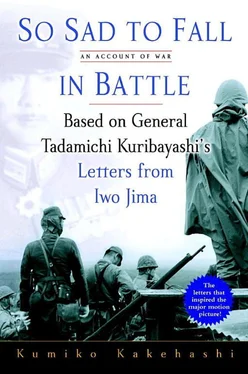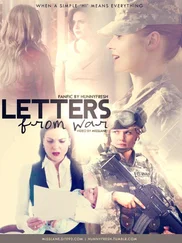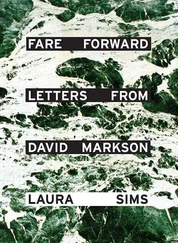Many Japanese people have seen this historic photograph; few, however, know what was used for the flagpole.
Lieutenant Colonel Johnson had given a flag to his men as they headed up Mount Suribachi, but he did not provide any flagpole for it. In both the first and second flag raisings, marines procured the poles from whatever was on the top of the mountain. It was Corporal Robert Leader and Private First Class Leo J. Rozek who found something that fit the bill: a length of metal piping that lay amid all the debris on the summit.
The pipe belonged to a cistern that the Japanese forces had built to collect rainwater for drinking. The cistern had been completely destroyed in the American air raids, and the pipe itself was riddled with holes.
To the marines, that pipe was no more than a piece of junk among a pile of debris. To the Japanese it was much more. The true value of that grubby pipe could only be understood by people who had known the agony of being parched, or had watched their comrades die begging for a drink of water.
The American soldiers had supplies of canned water to drink. During the battle, a Japanese soldier wrote in his diary: “I heard rumors that the Americans drink canned water. Is it possible such a thing exists in this world?” Of course it existed. Every landing craft was loaded with six thousand cans, each of which held eighteen liters of water—and there were seventy-three landing craft in all. The marines called Iwo Jima “hell,” but at least they did not have to suffer from thirst.
The Stars and Stripes waved over Iwo Jima, a declaration of America’s victory and America’s conquest. But the pole that held that flag aloft was the wreckage of a system that had helped sustain life for the more than twenty thousand Japanese troops on the island. Frozen forever in that incomparable photograph, a cruel and bizarre juxtaposition is still exposed to the eyes of the world.
—
IMMEDIATELY AFTER THE FIRST flag had been raised on Mount Suribachi, a motorboat dropped off a number of men on the island. They disembarked on the stretch of shore that the Americans had dubbed “Green Beach,” the corner of the south shore closest to the base of Mount Suribachi.
Two men stood side by side upon the black sand that four days before had clutched at the ankles of the marines and hampered the caterpillar tracks of the tanks. They had a good view of the Stars and Stripes fluttering on the summit of Mount Suribachi.
One of the men wore a gray sweatshirt over his khaki uniform. He said to his companion: “Holland, the raising of that flag means a Marine Corps for another five hundred years.”
Holland was Lieutenant General Holland M. Smith. And the old general’s eyes swam with tears as he thought back on all the heroic feats of “his marines” and all the casualties they had endured. This would be his last command.
The man in the sweatshirt was James V. Forrestal, secretary of the navy. Forrestal had come all the way out to the Pacific to witness firsthand the marine invasion of Iwo Jima and had been in the command ship USS Eldorado off the island, watching the campaign unfold.
Overriding the opposition of his entourage, who feared for his safety, he went ashore. Secretary Forrestal had walked the beaches of Normandy seven months earlier and was equally determined to inspect the Iwo Jima beachhead himself.
LIEUTENANT GENERAL SMITH was commanding general of the U.S. Marines Expeditionary Troops. The chain of command was as follows: above Smith stood Vice Admiral Richmond K. Turner, U.S. Navy, commander of the Joint Expeditionary Force; above Turner was Rear Admiral Raymond A. Spruance, commander of the Fifth Fleet; above him was Admiral Nimitz, commander in chief of the Pacific Fleet. Above them all was Navy Secretary Forrestal, who stood at the apex of the navy power structure.
Well aware that he could not allow the navy secretary to go ashore by himself, Lieutenant General Smith accompanied him and his entourage to the beach, and was thus able to witness a moment of history.
There was a rationale behind Forrestal’s remark to Smith about “a Marine Corps for another five hundred years.” The marines were often seen as little more than an afterthought or add-on to the navy. The question of whether there was a genuine need for them was often debated.
The Marine Corps was originally organized as an affiliate of the navy and was a small force responsible for onboard security and sharp-shooting. Its role was reevaluated in the years after World War I. Suspecting that the islands of the Pacific could become the scene of fighting in the near future, the American military decided that an elite force specializing in amphibious landings was needed and gave that role to the marines. The American forces were running combat simulations against Japan in the Pacific years before Pearl Harbor, at a time when the Japanese military had not even started developing a strategy toward America.
Over time, the marines were built up as a force able to conduct independent amphibious operations far away from the continental United States. As the U.S. military establishment had predicted, the day came when battles had to be fought on the islands of the Pacific, and the marines acquitted themselves nobly in landing operations against the Japanese on Guadalcanal, Tarawa, Peleliu, Saipan, and Guam, among other places.
The Americans raising the Stars and Stripes on Iwo Jima—on the Japanese homeland—was a historic moment. And it was the marines who did it. In so doing, they forcefully justified their existence and proclaimed their worth to the world.
The marines were the ones who landed under enemy fire and secured positions for the rear guard units to take up; the marines were the ones who first made contact with the enemy. But despite exposing themselves to greater danger in this manner, not only were they less respected than the other three services—the army, navy, and air force—they were also often looked down on as a bunch of ruffians. Now a single flag guaranteed that they would get the respect that their dangerous, brutal missions deserved for five hundred years—such was Secretary Forrestal’s promise.
The following day, February 24, Forrestal left for Guam. With the landing operation completed and Mount Suribachi, seen as the island’s key strategic point, in American hands, Forrestal thought he had seen everything he needed to see. But the fight was by no means over.
Neither the navy secretary nor the American public going crazy over the flag-raising photograph had any way of knowing that the marines would need another thirty days to conquer Iwo Jima completely.
Of the forty men who stood on the summit of Mount Suribachi at that historic moment, only four were able to walk on board the ships that would take them home. Of the remaining thirty-six, the lucky ones left on stretchers; the unlucky ones died and were buried on the island.
THE FALL OF MOUNT Suribachi within only four days of the Americans landing was a severe blow to Kuribayashi.
He had planned for the decisive battle to be fought from the defensive positions that ran from the center to the northern part of the island, so he was ready to let Suribachi go at some point, but he had hoped that the garrison defending the summit would hold out for a minimum of ten days and keep the enemy pinned down.
Mount Suribachi fell earlier chiefly because the tunnels linking it to the Motoyama area in the center of the island had not been completed in time. The Japanese had built a total of 18 kilometers of tunnels by the time the Americans landed, but those between Mount Suribachi and Motoyama had not yet been joined. Mount Suribachi was cut off when the Americans occupied Chidorigahara, which lay between the two.
Had the tunnels between Mount Suribachi and Motoyama been ready, it would have been possible to travel back and forth between the two installations without having to emerge aboveground. The Japanese would have been able to stay in contact; more important, they would have also been able to move troops, weapons, and ammunition. Kuribayashi must have bitterly regretted the shortage of materials that hampered his tunnel-building program.
Читать дальше












